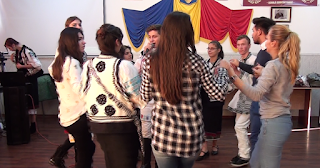The City Council of San Sadurniño carried out a project of locating and identifying the possible NEETs within the limits of its territory. Therefore, this service was divided into four phases:
-
Implication of the key agents.
-
Investigation of the youth.
-
Management of two participative meetings.
-
Communication and spreading of the service.
First
of all, it should be highlighted that San Sadurniño is quite a big
town within its geographical area, with a low and spread population.
These geographical characteristics shape the social dynamics,
influencing the ways of relating, communicating and mobility. That’s
why it is necessary to know this territorial configuration when
starting a research-action process with the young people of the
council.
Being
aware of this context, it was essential TO
INVOLVE KEY AGENTS
from
San Sadurniño. There were four meetings in July: with several
associations and sport clubs, local experts, local politicians, and
the educative centre. It was necessary to ask for collaboration in
order to create a database with young people from San Sadurniño, and
also to spread the participative process.
The
next step was visiting sport clubs, cultural associations, and other
strategic and informal points where young people meet (i.e. bars,
pubs or parties like “Sons na Cortiña” Festival) in order TO
INVESTIGATE THE YOUTH.
This was an attempt to contact as much young people as possible by
going to their meeting points, taking into account that usual ways of
communication would not work due to the spread of population and the
apparent indifference young people have towards the activities
promoted by the council. Young people found in these places were
individually asked about their present situation (working, studying,
working and studying, studying and looking for a job, etc.), but also
to find out their concerns about activities, equipment, and local
services.
By
the end, the database was formed by 121 youngsters, of which 48 were
between 18 and 29 years old, and 73 under 18. Once the database was
created, every person was contacted both through calls and instant
messages to invite them to the participative meetings. It is worth
mentioning the innovative communication, at least in this council,
since it was adapted to the habitual ways of communication of young
people (texting and social networks). In particular a video was
created (https://www.youtube.com/watch?v=OxJeWaO6d4w)
and was sent through an instant message app to those people on the
database, so they could be informed and could resend the video to
their own contacts.
TWO
PARTICIPATIVE MEETINGS
(“opportunity cocktails”) were held and in order to make easier
the attendance of many youngsters, they took place at different times
(morning and evening) and days (weekdays and weekend). Thus, the
first meeting was placed on the Monday 24th of October at 5pm, and
the second one on the Saturday 29th of October at 11am.
At
the two meetings held, some interesting information was detected. On
what refers to the term “NEET”, at first it seemed to be a
confusing definition for the participants. They wouldn´t know which
characteristics defines a person as a “NEET”, but at the end they
all agreed describing a “NEET” as a person with a lack of
interest to find a job. This means, a person who doesn´t study and
has no job but is trying to look for one, should not be considered as
a “NEET”. Only those who “do not study, do not work, and do not
want to” due to a lack of motivation, or even because it is more
comfortable (“their parents allow them to”) can be defined as
NEETs.
Apparently
the young people who answered the survey and attended the meetings
were not NEETs, but they show worries about their future. We found a
growing worry due to the lack of opportunities and the difficulties
to find a job after finishing their studies. They also think that
this lack of opportunities may end up in less motivation, and
therefore, inactivity. Moreover, the transmission of preconceived
ideas through family and school is another factor for lesser
motivation. These ideas spin around the supposition that University
offers more job opportunities than occupational training courses.
Anyway, technical and health degrees have more reputation than arts
and social sciences related degrees. That may be one of the reasons
why young people find an extra pressure that, added to the few
opportunities, leads to becoming a NEET.
This
research on the youth of San Sadurniño resulted in 21
proposals
to respond to these scenarios of future, which can be summarized in
the following topics:
-
Training and employment
-
Activities
-
Municipal activities and services
-
Sports and cultural facilities
-
Communication
-
Mobility
A
way to fight youth inactivity is to offer job training, courses, and
also cultural and leisure activities. However, it is useless to have
a great offer of activities if that information does not reach the
audience, which seems to happen in San Sadurniño. In fact, the
youngsters pointed out both in survey and meetings, that the
communication is not effective. They don´t know enough about the
offer of activities and services the administration has. If the
information does not reach its audience, the activities will not have
enough attendance and, therefore, will be cancelled. In this sense,
people attending the meetings gave possible solutions to improve the
communication from the council towards the youth. In particular they
suggested the use of images with almost no text through apps like
Instagram or Whatsapp, that is to say, adapting the ways of
communication that young people have.
As
important as improving the communication is to adapt the offer to
what the youth demands. In that way, the meetings were also used to
find out what the young people from San Sadurniño are interested in.
It was easy to see, with differences between sex and age, the
interest in sports, information about employment, tourism (travelling
abroad, languages courses), shows (dancing, music, theatre, etc.),
computer science, videogames and workshops for artistic expression,
among other activities. In order to encourage the attendance to the
activities offered by the council, it was suggested to create a
meeting point, for example the Youth House. It would be ideal if it
was filled with contents, to be used for the younger ones (under 18)
for leisure, and also for those over 18 with a job training focus.
Another
way to encourage the participation of youngsters is to let them
participate in the decision-making process of politics and
activities. The people who attended the meetings wanted the Council
to co-desing the local youth politics, activities and services. This
idea consisted in regular meetings of youth sector-based committees
with political workers, or the reservation of an item for youth
policies in the participatory budgeting among other ideas.
Finally,
must be mentioned that the COMMUNICATION
OF THE SERVICE
was based on a continuous creation of contents for social networks
and council’s webpage. In fact, there were posted 11 news and
events on web page, facebook, twitter and local press, with 3.340
followers in social media channels. Besides that, every person of the
database was contacted both through calls and instant messages to
invite them to the participative meetings.
















